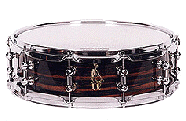Snare Drum
History
 The earliest form of the snare drum was the medieval tabor. The tabor is a doubleheaded drum. It often has one simple gut snare. The tabor was often played along with a three-holed pipe in the Middle Ages. Today this combination can still be found in modern European folk music.
The earliest form of the snare drum was the medieval tabor. The tabor is a doubleheaded drum. It often has one simple gut snare. The tabor was often played along with a three-holed pipe in the Middle Ages. Today this combination can still be found in modern European folk music.
The tabor gradually increased in size during the 15th century. It emerged as a military instrument by the 16th century.
It was popularized by the fife-and-drum corps of Swiss mercenary foot soldiers. This version of the drum was a large instrument carried over the player's right shoulder, suspended by a strap. It is to this instrument that English word "drum" was first used.
Laces were used to increase the tension of the heads. It was accomplished by lacing a cord in a W or Y pattern around the shell. This method was replaced with the development of a top hoop. This hoop was used with tension screws, which could alter the tautness of the drumhead.
Snare drums were primarily used as military instruments and are still associated with the infantry and the fife. They were introduced into other music in the 18th century when it was first used in the orchestra. In the 19th century it replaced the tenor drum of military bands.
Description
The snare drum is made from two heads attached to either side of a shell. The orchestral snare drum has a diameter of 15-16 inches and a depth of 5 inches. Eight to ten snares are stretched across the lower head.
The shell is made of metal or laminated wood. The head is made of either animal skin or plastic. There are two hoops for each head. The bottom hoop is around the edge of the head. It is attached to the shell by a top hoop and either tension rods and thumb screws or spring loaded tension units.
Sound Production
Sound is produced when the player creates a vibration by striking the drumhead with a drumstick made of wood. This causes the snares to vibrate against the head as the membranes are struck. The snares produce a dry, rattling sound when vibrated. The resonator is the wall of the drum.
